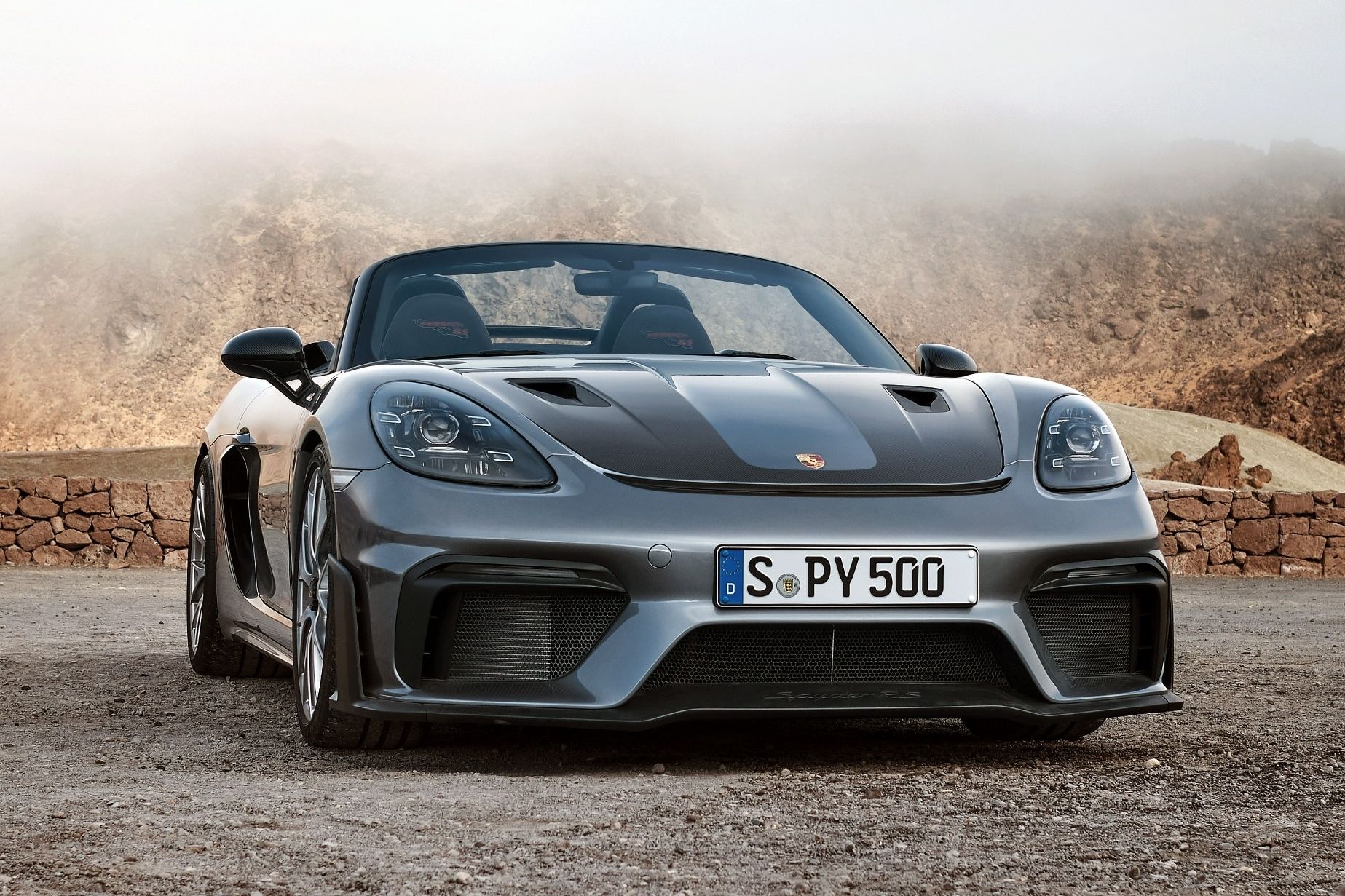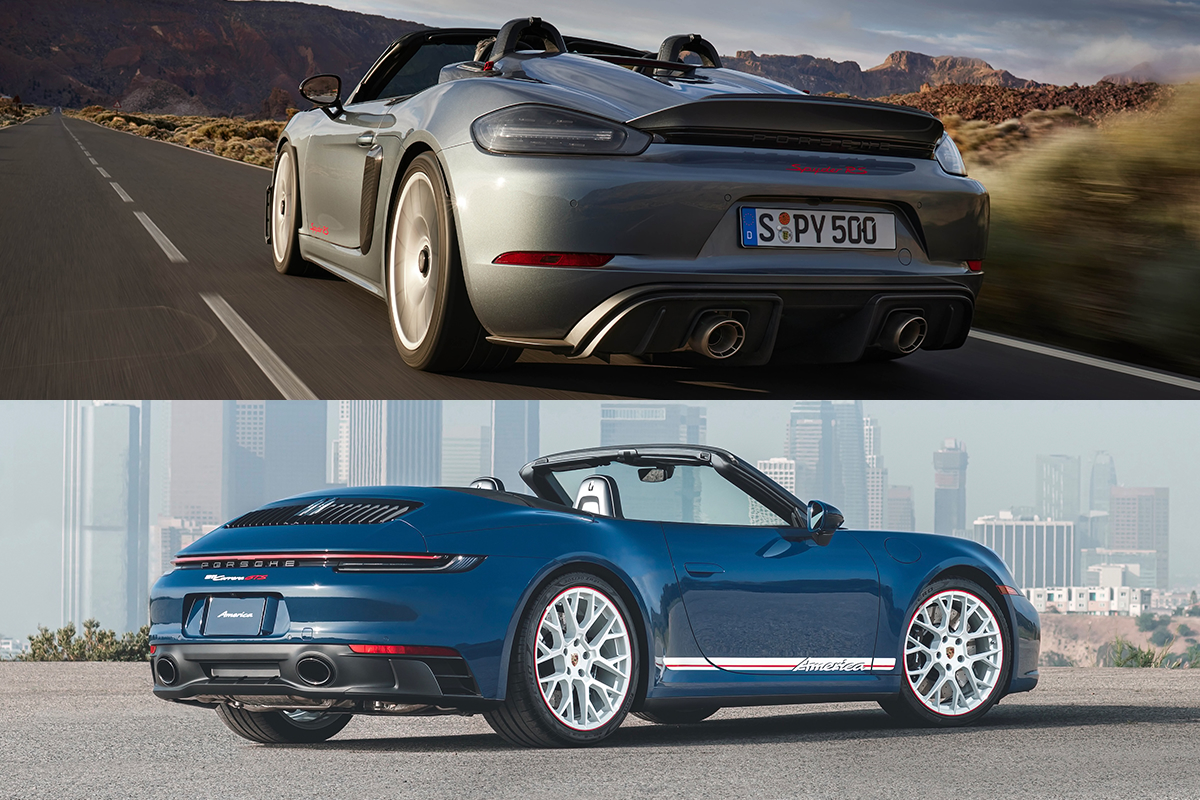
Porsche has just revealed the ultimate Boxster yet in the form of the 718 Spyder RS, and its price tag of $160,700 places it right in the mix with what may be the sweet spot in the 911 Carrera Cabriolet range: the GTS at $163,700.
If you want a Porsche, the wind in your hair, and have this much to spend, it creates an interesting conundrum. The 911 is obviously positioned higher up in the Porsche hierarchy, but the Spyder RS comes with that delicious 4.0-liter naturally-aspirated flat-six engine donated from the 911 GT3.
One can be had with a manual and one can't; one is a lot more practical than the other, yet they're closely matched in terms of straight-line performance. Here's how two great Porsche drop-tops shape up against each other.
Design: Naughty Or Nice?
It's impossible to choose a clearcut winner in this department, and that's not only because styling is always subjective. Whereas the 718 Spyder RS screams performance from every angle, the 911 Carrera GTS Cabriolet - even with its sportier GTS bits, pictured here as the GTS Cabriolet America Edition - has smoother, cleaner lines that are more in tune with the boulevard cruiser image of a convertible.
NACA ducts, a ducktail spoiler, and a manually-operated roof are all aimed at lowering weight and enhancing the aerodynamic efficiency of the RS. Those dual humps behind each occupant completely change the profile, while the gaping intakes and carbon fiber add up to a car that looks ready to play.
By contrast, the GTS is a classier affair with its classic lines and instantly recognizable rounded headlights with four-point daytime running lights. It sits low on 20-/21-inch wheels, and here the roof can be raised or lowered at the touch of a button.
We appreciate both cars for what they are, be it the unashamedly sporty RS or the subtler GTS.
Interior: Sporty And Sportier
There is a discernable difference in quality and sophistication when stepping from a 718 into a 911, and that remains the case here. It's not to say that the 718 is badly built, but you can tell that this car is based on Porsche's junior sports car. In the RS, seating is provided for just two, but this special model benefits from full carbon fiber bucket seats with a carbon-weave finish, leather covers, and Race-Tex inserts. Leather extends to the dashboard, making for a higher-quality finish than in cheaper Boxsters.
In the 911 Carrera GTS Cabriolet, there is a 2+2 layout so the tiny back seats can be used for emergencies or for extra packing space. It has a larger touchscreen interface and many more luxurious options for upgrading the seats, such as Club Leather in Truffle Brown over 14-way power front seats with memory. The GTS still has a very driver-focused cabin and a stellar driving position, and it's the pick of the two if you want a daily driver that's relatively comfortable on the highway and focused enough to enjoy through a mountain pass.
The Spyder RS' snug cabin isn't as plush but its overt sportiness will be a thrill on the track. However, we're picking the GTS in this category as its interior is more versatile, can be set up for greater comfort or sportiness, and has more creature comforts.
Performance: Two Unique Ways To Blow Your Hat Off
These two drop-tops diverge most in this category since the Spyder RS comes with the 4.0-liter flat-six that relies on natural aspiration. This high-revving beast of an engine is the same one used in the 911 GT3, and it delivers 493 horsepower at 8,400 rpm and 331 lb-ft of torque. Its maximum engine speed is 9,000 rpm.
The short-ratio seven-speed PDK dual-clutch automatic transmission is the only choice for the Spyder RS, enabling a swift 3.2-second blast for the 0-60 run, and it'll continue to a top speed of 191 mph.
As for the Carrera GTS Cabriolet, it couldn't be more different, with less power but far more torque thanks to being twin-turbocharged. Its 3.0-liter six-cylinder engine produces 473 hp and 420 lb-ft, but the fun ends much sooner than in the RS at 7,500 rpm. That said, you won't need to work the GTS nearly as hard, thanks to the peak torque being delivered from just 2,300 rpm.
With the PDK transmission, the GTS will reach 60 mph in 3.4 seconds, just 0.2 seconds behind the lighter (by 373 pounds) Spyder RS. The top speed in the GTS is almost identical at 192 mph.
But the GTS has another trick up its sleeve: it's the only one of the two that can be had with a seven-speed manual. This has quite an effect on performance as the 0-60 time drops to 4.1 seconds, but it's an enticing option not offered for the Spyder RS at all.
As far as the performance figures go, these cars are closely matched on paper when the GTS is equipped with the PDK. But there is simply no denying that the Spyder's flat-six engine sounds better than the turbo-six in the GTS, while the lower weight of the 718 should give it the edge in agility. The Cayman GT4 RS is a dynamic benchmark among small sports cars, but the Spyder RS comes with reduced spring and damper rates that Porsche says achieve the more relaxed driving style of a convertible. We expect nothing about this car to feel relaxed when we drive it, though, but the GTS may emerge as the car with a wider breadth of talent between comfort and cornering thrills, plus it has the option of a manual.
Pricing And Verdict: No Wrong Answers
As the prices at the start of this comparison show, just $3,000 separates these two exceptional Porsche convertibles, which isn't much when you consider that both cost in excess of $160k.
The primary advantage of the 718 Spyder RS lies in its unhinged 4.0-liter engine, making this the pinnacle of the Boxster lineup. This, together with the aerodynamic improvements, cheeky styling, and chassis alterations in a fairly light body, will surely have created one of the most spirited drop-tops you can buy at any price.
The 911 Carrera GTS Cabriolet strikes back with its more elegant proportions and approachable character, but it'll still bring a big, silly smile to your face when used in anger. It's more spacious, has a more modern interior, and will be easier to live with. That turbo-six mill is incredibly flexible and sings a decent tune, but it's outclassed by the Spyder's free-breathing 4.0-liter. Then again, the GTS does let you change gears with your leg and hand and not just your fingertips if you so wish.
If we were buying one for ourselves, we'd be tempted to spring for the GTS. But if our time behind the wheel was limited, it's hard to look past the new Spyder RS.

